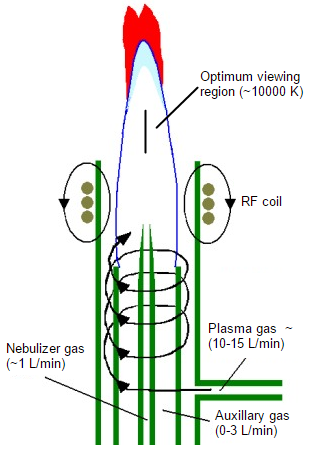Inductively Coupled Plasma (ICP)
- Page ID
- 75407
The inductively coupled plasma (ICP) was developed by Velmer Fassel & Stan Greenfield in the 1960s. The following is a picture showing the highlights of an ICP. There are MANY people that have worked with an ICP in research. Click here to see more information.

The torch itself has a diameter of 0.5 to 1 inch (1.27-2.54 cm). The magnetic field oscillates at 27.2 MHz on the RF coil. Typically argon gas is the plasma gas and nebulizer gas (with the sample). The plasma formed contains a high proportion of cations and electrons. The electron density in a plasma is on the order of 1013-1015 electrons/cm3.
It is relatively simple chemistry! Some of the background that exists is from Ar, OH from H2O, Black Body, and N2 (from air). This is much hotter than a flame (10,000 K), which causes a high level of ionization for elements with low ionization energy (which are?). There is more complete atomization/excitation. Based on the flow rates, the sample is in the observation region for ~2.5 msec. This system has good selectivity despite the many emission lines excited. Usually for a particular matrix, one can find an emission line that either has few interferences or for which interferences can be subtracted. The ICP is relatively stable, with relative standard deviation of the signal at ~1-2%. The linearity of response is 5-7 orders of magnitude since there is essentially no self absorption. General limits of detection are on the order of 1-10 ppb for most analytes, but the LODs do vary based on the method of analyte introduction! Multi-detector systems can be used as well.


